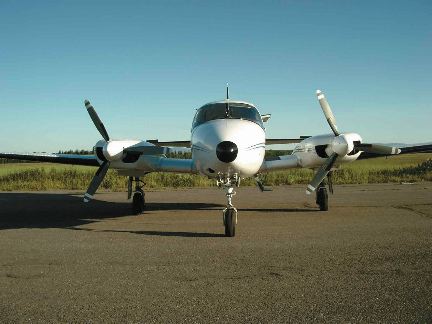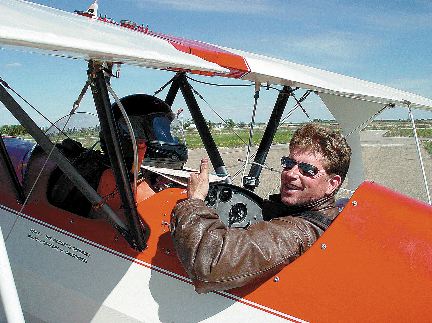Written by Kyle Storey
Prince George Citizen – view this article online
Published: Sunday, 15 March 2009
Vanderhoof pins hopes to commercial pilot program Vanderhoof mayor Gerry Thiessen sees the possibility of a commercial pilot program as a major boost to his community.
"We have a great facility here," Thiessen said. "The airport has lots of room and is open and accessible. We have no problems with mountains," or the ensuing air inversions which plague many B.C. airports.
The community has been looking for ways to increase the use of its airport, especially since the infusion of nearly $1.6 million to install a lighting and navigation system.
The community’s commitment can be summed up in its $100,000 contribution to the project. The federal government contributed $550,000 through Western Economic Diversification, the Northern Development Intitiave Trust (via the Economic Diversification Infrastructure funding program) contributed $466,000, the B.C. transportation ministry added $388,000 and the Nechako-Kitimat Development Fund added another $50,000.
"I think a commercial pilot program would really help, and not just at the airport," said Thiessen. The mayor saw the possibility of a number of spinoffs for his town including accommodation for students.
"In fact, we’ve already been looking at a couple of options," he said.

A degree-granting, commercial-pilot program based in Vanderhoof
would provide needed economic stimulus to Vanderhoof and area.
Work on the airport has attracted interest from as far away as Newfoundland. Completion of the project is expected by the end of the year.
That work is key to the involvement of the College of New Caledonia and makes an accredited flight-training program a serious possibility.
"We strongly believe there is an opportunity to create a successful, internationally recognized commercial pilot program in this community," said Maureen Mallais, interim regional director of CNC’s Nechako campus.
"The support from the District of Vanderhoof has been critical in moving this forward. Former mayor Len Fox and Kathie LaForge, Vanderhoof Economic Development Officer, wholeheartedly supported this initiative, providing a letter of support as well as assistance in developing the proposal.
Also, without the upgrades at the Vanderhoof Municipal Airport, specifically the
lighting and GPS access, this program would not be even under discussion," said Mallais.
Written by Kyle Storey
Prince George Citizen – view this article online
Published: Friday, 13 March 2009
VANDERHOOF — Trial balloons are meant to float skyward, but Guardian Aerospace owner Eric Stier hopes his idea will sprout wings. "I’ve been mouthing off for six years about how the community could support a much larger aviation-training facility," said Stier. "Now’s the time."
That potential began to creep toward fruition when improvements were approved for Vanderhoof’s airport. The airport is going from day-only, no-instrument landing to a situation where landings can be done on a 24-hour basis. The genesis of this increased usage is the installation of a lighting and navigation system slated to be completed this year.
This major upgrade came about thanks to funding of about $1.6 million. The money came to Vanderhoof through Western Economic Diversification, the Northern Development Intitiave Trust (via the Economic Diversification Infrastructure funding program), the B.C. transportation ministry and the Nechako-Kitimat Development Fund as well as from the municipality of Vanderhoof.
"I’ve been pushing for the airport to reinvent itself or it would become a (glorified) wheat field," said Stier. "I’d like to take credit, but the community really got behind the idea. The politicians supported it and now the potential is (almost limitless)."

Guardian Aerospace owner Eric Stier, top, is enthusiastic about the idea of a fully-accredited flight-training centre based in Vanderhoof
In the short term, an upgraded airport means residents of the Stuart-Nechako Region will have access to 24-hour medevac services. "It’s the kind of thing people take for granted. But once you need the service, or it saves the life of a loved one, you realize how invaluable it is," said Stier.
In the long term, Stier hopes the airport improvements will help his dream take flight.
His dream is to turn Vanderhoof into a fully-acredited, flight-training centre. It would be the only one north of the Lower Mainland.
People could be excused for seeing this as pie-in-the-sky idea, except for the fact it is being taken seriously on a number of levels. The local politicians are behind it. The Vanderhoof council and mayors past and present see the idea as one key to an improved economic future for the area.
If that wasn’t enough support, the College of New Caledonia is solidly behind the concept. To the point, CNC is in the middle of a feasibility study. Susan Mooney, a project planner with the Nechako campus, is in charge of the study and she’s encouraged by what she’s seen so far. "We’ve talked to the colleges (currently running degree programs in pilot training) in the Lower Mainland and they’ve been quite open about what has worked and not worked for them." To make a college program work, there has to be an identifiable need.
To this point, Mooney has surveyed aerospace firms from across the North, and most are supportive. "Many of the companies we’ve surveyed are interested in seeing the commercial pilot program get off the ground. Some companies have even made suggestions about what they would like the students to learn," she said. "A diploma is not required to get a pilot’s licence, but combining that training with a more well-rounded education would make these students more valuable to a more diverse group of employers."
Those potential students should have plenty of job options. "In 2001 we graduated 1,000 to 1,300 pilots in Canada. Last year we graduated 600," Stier said. "It has been estimated the world will be needing some 60,000 pilots over the next 12 years. It seems like there is an opportunity here."
Stier also sees the downside to this explosion of job opportunities. He said training and keeping employees in the North is problematic. "When we hire someone from Vancouver, It seems like the first opportunity that comes along, they’re gone.
Training northern students, in the North, would increase the likelihood of them staying in the North. "In many ways our commercial pilot program could be like the Northern Medical Program (at UNBC). Training people here should help (keep people here)," said Mooney.
Vanderhoof may seems like an out-of-they-way place for a program like this. Especially with the proximity of Prince George and it’s high-traffic, modern airport, but that’s precisely why Vanderhoof makes sense.
According to both Stier and Mooney, it’s the proximity of the airport to the college which makes the location ideal. According to the feasibility study, the area’s topography of gently rolling fields and year-round access makes it ideal for flight instruction. In addition, its light air traffic makes it attractive for such a program compared to other, more congested, training facilities.
The study also outlines some of the community benefits which include:
- Specific knowledge-based infrastructure will create long-term economic benefits by creating employment for instructional staff, support people, and aircraft and equipment maintenance and repair;
- Enhance local businesses which would provide such things as food, shelter, transportation and other suppliers;
- Increase cultural diversity by attracting and retaining skilled labour and professionals from other parts of the province and country;
- Provide international exposure which could lead to enhanced tourism.
The study also indicates there has been a worldwide shortage of commercial airline pilots since 2000. Although the current economic slowdown has slowed the demand for commercial pilots in the last few months, an overall shortage is expected to continue due to retirements in already aging workforce. Mooney expects to wrap up the feasibility study by late spring.
With the help of CNC, his dream of making Vanderhoof an aerospace centre is coming more clearly into focus and Stier is beginning to feel all the time and effort has been worthwhile. "I could have gone to work for Air Canada and had way less stress (over the years). But now I’m excited, again."
Not so excited, however, that he doesn’t see some irony in his situation over most of the past decade. "I’m just frustrated that visionaries often receive no support for often excellent ideas…which could easily be developed with some financial support. That being said, if I had the money I would have talked less and built it on my own."



